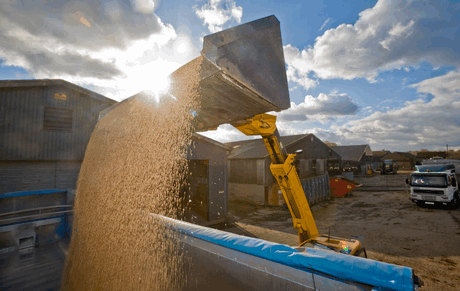Temporary help to dry grain

Backlogs of wet grain have been a common sight this year, as drying capacity struggles to keep up with demand. Louise Impey seeks some solutions.
Failure to dry and cool wet grain properly could lead to rejection from both food and feed uses, warns Tim Wontner-Smith of CSL.
“The risk is from insect infestation and mould growth,” he says. “Mould growth is a particular concern because it can lead to the production of mycotoxins – particularly the highly toxic ochratoxin A.”
The EU limit for ochratoxin A in cereal-based foods destined for human consumption is less than 5ppb, he adds.
He accepts that drying grain down to the required moisture content is challenging this season, but reminds producers that cereals must be dried to 14.5% as soon as possible.
“This is the best-practice figure. The real risk from mould growth occurs in the period immediately after harvest, so if it comes in above 18% moisture content, even a short delay can cause problems.”
Where backlogs are delaying the drying process, the priority should be any grain above 18% moisture content, says Mr Wontner-Smith.
“Get the wettest grain dried immediately. Grain below 18% moisture should be cooled to prevent it heating up while this is taking place.”
Mites are another concern, with low moisture content again critical, he says. “Again, the important figure is 14.5% moisture, which stops them developing. Longer term, you need to bring moisture down to below 13% to prevent surface populations caused by moisture uptake in the winter.”
Cooling grain to below 5ºC will prevent mites breeding and will kill other insects, he adds. “But the initial target for cooling is 15°C, which should occur within two to three weeks of harvest. Then get it to the lower level by the end of December.”

Virtually all grain has required drying this harvest before delivery
Temporary drying solutions, available for rent, may offer respite for some farmers in this unusually wet, prolonged harvest, suggests Neil Smith of Aggreko.
“With grain, layer drying is a fast way of getting moisture out of the bulk,” he says. “In effect, it flash-dries the product.”
This method uses a large, indirect diesel-fired heating system, which can be run successfully on a farm’s power supply, to blast high volumes of pressurised air under the heap of grain.
“The grower has to build a platform or floor, resembling a perforated air duct system. When the grain is on this platform, the system is switched on. Once dried, you can then rely on ambient temperatures to keep it stable.”
While Aggreko can supply the necessary equipment onto farm within 24 hours, the temporary floor has to be assembled by the farmer, adds Mr Smith.
“I’ve seen them made out of wooden pallets, with a loose woven cloth put over the top and the sides boxed in with straw bales. Pressurised air put underneath such a structure should rise vertically, drying the grain as it goes.”
Mr Smith points out that every farm site is different, making it impossible to give guidelines on how long the equipment will be needed or what it will cost.
“The first site survey is free of charge,” he says. “We have to look at where we will put the equipment and what the power supply is like, as well as the size and structure of the building.”
The system can work as both heating and ventilation, he adds. “It’s a big advantage. You can switch between them, according to conditions.”
Larger farms and organisations may benefit from having a temporary generator on site instead, he suggests.
“Renting this sort of equipment avoids the need for capital expenditure, but allows you to keep grain in the best possible condition. All the Aggreko machines run on red diesel.”
Desiccant dehumidifiers are another possible solution, says Mr Smith. “They are standalone machines, which can be plugged in and left to run day and night. They remove moisture from the air and reduce relative humidity to a pre-set value.”
Energy use is very efficient with these, he adds. “Their main role is to stop fungal growth – and that seems to be very important in grain this season.”
Should grain need to be dried to 14.5%, particularly if it to be used for immediate processing? Join the debate on the FWi forums.

